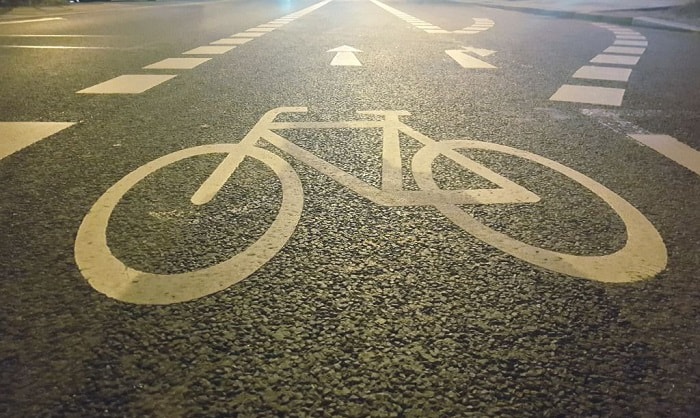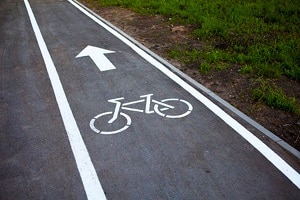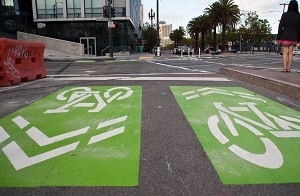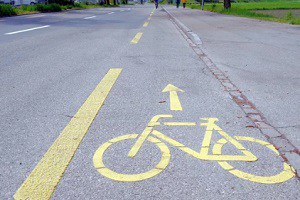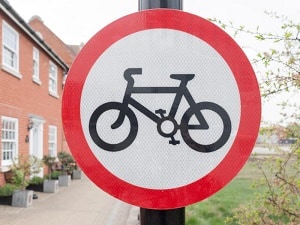Traffic signs direct traffic and help keep people safe on roadways. However, we need to be familiar with the many kinds of bike signs on the road to comply accordingly. But what do the bicycle signs mean?
The bicycle signs indicate that an area is designated as a bike lane. However, there are different types of areas for cycling. Let’s take a look at some of the most common types of bicycle road sign.
Keep reading to learn more.
Table of Contents
Types and Meanings of Bicycle Signs
1. Bike Lane Sign
Traversing the road can be dangerous for bicycles, but local administrators can facilitate safer conditions by allocating bike lanes. These are sections of the road that are reserved exclusively for bicyclists. Automobiles are not permitted to use this lane unless it is necessary to access parking or a roadway.
This marker is denoted by a symbol of a bicycle painted on the road. The standard marking will usually have an arrow symbol that shows the correct direction to go when using the path. These are usually on the right side of the road.
Bikes are not always required to stay on this lane, and there are also reasons for not wanting to stay on it. One common reason is that it is often in the “door zone” of parking spaces where a bicyclist may get caught by opening vehicle doors.
There are also buffered bike lanes, where there is an additional space beside it that no vehicle can enter. These allow extra space for bikes and provide additional safety.
A combination of “shared” and “arrow”, sharrows are denoted by a bike symbol with two arrow marks above it. The arrows show the correct direction for using the path as with other bicycle lane markings.
These sharrow cycling road signs mean the marked space is shared between bicyclists and motorists. They also encourage cyclists to keep a safe distance from the doors of parked vehicles.
You may also find sharrow markings on a green lane, but they mean the same thing—the color is simply there to emphasize the fact that the road is for cyclists too. For motorists, this sign means that they should look out for others using the same path.
3. Dashed Bike Lane
This symbol looks similar to the standard bike lane, but its lines are broken or dotted. This means that the space is not exclusive to bicycles and is shared with motorized vehicles as well.
In addition, automobiles can enter this lane to make a turn or enter an area. When this happens, they are expected to yield to cyclists.
Along with green lanes, this symbol serves as a bicycle warning sign to cyclists that they need to be cautious and must look out for vehicles that may not be aware of their whereabouts.
4. Green Bike Lane
This is another cyclist sign that is similar to the standard bike lane but with green coloring to highlight spaces where motorists are expected to cross. Similar to the dashed lane, motor vehicles are again expected to yield to bicyclists.
Generally, you’ll see two types of green bike lanes—one with straight lines and one with dashed lines. The main difference between them is that the latter does not allow cars—the only exception is when the vehicles need to enter a driveway.
5. Advisory Lanes (Edge Lane Road)
Advisory bike lanes are marked with a solid white line and dotted one on the right and the left, respectively. These are usually seen on small roads that expect less traffic, and they mostly function as standard bicycle lanes.
As cyclists have the right-of-way, motorists using these roads need to travel in the middle. Only when they need to pass oncoming traffic can they enter the designated area for bikes.
Bicyclists should expect motorists to use this path more than they would other types.
6. Bike Boulevard
This marking is denoted by a bike symbol accompanied by the text “BLVD” and indicates that the street has low-volume traffic with notable speed limits. The restriction is mostly for optimizing an area where cyclists can feel relaxed and safe.
It is common to see many other bike safety signs in a designated boulevard, such as the bike crossing sign, to provide cyclists with safer paths on major roadways.
While bicyclists are given priority in such areas, they are still expected to follow traffic rules and the right of way still applies to motorists and pedestrians.
In this space, drivers are not allowed to pass bicycles unless there is a safe allowance of 3 feet.
Different colors also indicate different meanings. In some rare cases, color can change its meaning depending on whether it has certain symbols.
While the green road marks a crossing area for motorists in a bike lane, a green bicycle symbol means that the path is recommended for cyclists. This is a bike route sign and is usually located on scenic routes or low-traffic roads.
A yellow bicycle sign (or sometimes just a yellow diamond) serves as a reminder that the path is shared with bicycles. There is also the circle blue bicycle symbol, or a bicycle only sign, indicating that no other vehicles may pass.
8. Restriction Bike Traffic Signs
Seeing a sign of a red circle with a bicycle in the middle means that bicycles cannot be ridden here. It’s also worth knowing that just a big red circle without anything in it means all vehicles, including pedal cycles, are prohibited in that area.
Aside from the no bicycle sign, there are also other types of restrictions that make use of the red circle. A pedestrian zone sign would have symbols of a car and motorcycle in it; this means that pedal cycles may be used in such a space.
Bicycle Hand Signals
Aside from knowing the different markers, you can also make use of bike sign language to convey your intentions while on the road using hand gestures.
These hand signs can be used as a replacement for the signal lights on automobiles. Below are a few basic ones that you should get familiarized with.
One such basic bicycle hand sign is the turning signal; this involves sticking out your entire arm in the same direction where you intend to make the turn.
Alternatively, you may also raise your arm, bending at a 90-degree angle with your hand pointing up. This indicates you’ll turn in the opposite direction, meaning raise right to signal turning left. Note that they’re not legal everywhere, so it’s better to stick to the first one.
The stopping signal can be done in two ways, the first is to lower your left arm straight down with your open palm facing backward. The other method is to place your right hand at your back and make a fist; however, this is more commonly used for riding in a pack.
There are many other useful signals that would be worth your time to learn. These include signs for slowing, informing others of debris or hazards, or signaling to let others through. However, we’ll leave these for another time.
Conclusion
What do the bicycle signs mean? Familiarizing yourself with the bike road sign meaning of the most common ones is a good start. Keep building your knowledge, and it in turn will keep you safer while on a ride.
Which ones do you have trouble identifying; are there less common types that you see in your local vicinity? Tell us all about them in the comments section below.
Always ride safely.

“I ride my bike to work for years, but is that enough? Our carelessness towards our surroundings has taken a toll on the environment. And now, everyone is responsible for changes; even the most minor contribution is counted. With this hope and spirit, I started with my partner to establish Biketoworkday to help more individuals commute to their work sites on their bikes.”

